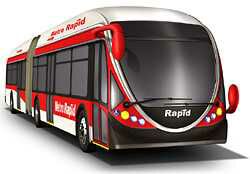
Light Rail Now! can be contacted at: Light Rail Now! |
Darrell Clarke is co-chairman of the Los Angeles-area Friends 4 Expo Transit organization, a transit advocacy group (and an underwriter of the Light Rail Now Project) which helped generate public and official support for the Exposition Blvd. light rail transit project, now under way. "Bus Rapid Transit" buses, with a sleek, streamlined look, and with more exotic propulsion systems, such as hybrid diesel-electric or gas-electric drives, are frequently being compared favorably to light rail cars, even being described as "train-like" and "light rail on rubber tires". But how do the "new look" buses actually stack up? I can personally speak to the new Los Angeles articulated buses from NABI (North American Bus industries), about to be operated on the new "Orange Line" busway of the Los Angeles County Metropolitan Transportation Authority (LACMTA) in the San Fernando Valley. One of these NABI buses was used as a backdrop for an MTA Earth Day press event this past spring, which I attended.
Santa Monica has not rushed to embrace hybrids. According to a Big Blue Bus representative, the agency has invested in LNG infrastructure for air quality, and there aren't LNG-fueled hybrids available. in regard to a comparison of CNG vs. diesel, the latest Santa Monica LNG New Flyers are slightly quieter and smoother, but more similar than different compared with older ones.
The Long Beach, California transit agency is acquiring a number of hybrid buses.
Recently I visited Long Beach to evaluate some of these new 40-foot hybrids, and found
a number of them on the downtown transit mall next to the Blue Line light rail transit
terminus. (A short sound video of one of these, playable with Windows Media Player, is
available online. For download instructions, see: My subjective take was that these buses produce more of a whine sound, with a little engine rumble on acceleration. It's definitely not silent (or as quiet as my Prius), but rather less noisy than a conventional diesel or CNG/LNG bus. Unfortunately, it was not a convenient opportunity to take a ride on one. On the basis of these personal experiences, plus what I know of technical developments and experiences elsewhere, I think there is a role for hybrid buses to quickly provide upgraded service on existing boulevards. But I believe they will remain inferior to light rail in a number of respects:
· Smooth ride on rails vs. uneven pavement for bus; Light Rail Now! website Updated 2005/08/09 |
|
|
|